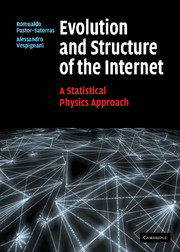Book contents
- Frontmatter
- Contents
- Preface
- List of abbreviations
- 1 A brief history of the Internet
- 2 How the Internet works
- 3 Measuring the global Internet
- 4 The Internet's large-scale topology
- 5 Modeling the Internet
- 6 Internet robustness
- 7 Virtual and social networks in the Internet
- 8 Searching and walking on the Internet
- 9 Epidemics in the Internet
- 10 Beyond the Internet's skeleton: traffic and global performance
- 11 Outlook
- Appendix 1 Graph theory applied to topology analysis
- Appendix 2 Interface resolution and router topology
- Appendix 3 Numerical analysis of heavy tailed distributions
- Appendix 4 Degree correlations
- Appendix 5 Scale-free networks: scaling relations
- Appendix 6 The SIR model of virus propagation
- References
- Index
11 - Outlook
Published online by Cambridge University Press: 12 January 2010
- Frontmatter
- Contents
- Preface
- List of abbreviations
- 1 A brief history of the Internet
- 2 How the Internet works
- 3 Measuring the global Internet
- 4 The Internet's large-scale topology
- 5 Modeling the Internet
- 6 Internet robustness
- 7 Virtual and social networks in the Internet
- 8 Searching and walking on the Internet
- 9 Epidemics in the Internet
- 10 Beyond the Internet's skeleton: traffic and global performance
- 11 Outlook
- Appendix 1 Graph theory applied to topology analysis
- Appendix 2 Interface resolution and router topology
- Appendix 3 Numerical analysis of heavy tailed distributions
- Appendix 4 Degree correlations
- Appendix 5 Scale-free networks: scaling relations
- Appendix 6 The SIR model of virus propagation
- References
- Index
Summary
The Internet is such a rapidly evolving system that sometimes the effort put in its study might appear as extenuating and futile as Sisyphus' pursuit. Indeed, one cannot but ask the question: Would the picture and results obtained today still be valid for the Internet of tomorrow?
The scientific community has just started to partially understand the complex properties of present Internet maps, as new and more ambitious mapping projects are being developed, and new kinds of networks are making their appearance, posing new theoretical and experimental challenges. For instance, P2P and ad-hoc networks define a new class of dynamical system for which new types of monitoring infrastructures and different modeling frameworks need to be developed.
Another rapidly changing aspect of the Internet is related to traffic load and performance. The traffic in the Internet is steadily increasing, due to users' demands, along with the available bandwidth of communications lines. Unfortunately, we have not yet achieved a proper theoretical understanding of the interplay and mutual feedback between topological features and traffic load. This makes it very difficult to forecast if the existing infrastructures, as well as new networks joining the Internet, will reorganize in view of this interplay, providing a different global picture of the Internet.
As if all that were not enough, new technical improvements, at the software, hardware, and protocol levels, are constantly changing many of the mechanisms that rule the fundamental processes that make the Internet work at the “microscopic” level.
Information
- Type
- Chapter
- Information
- Evolution and Structure of the InternetA Statistical Physics Approach, pp. 226 - 228Publisher: Cambridge University PressPrint publication year: 2004
